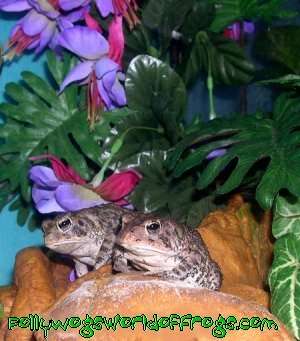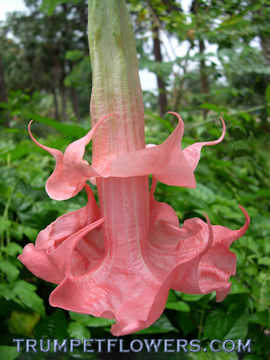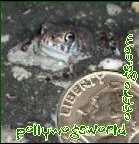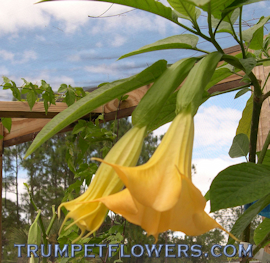Caresheet for American Southern Toad
 This toad grows to 4 1/2". A large frog, they have very prominent cranial crests and paratoids.
Depending upon the environment you find him in, he can be brown, reddish, orangish or even near-black. An occasional light stripe can be seen down the middle of the back. Males have dark throats, especially during the breeding season.
This toad grows to 4 1/2". A large frog, they have very prominent cranial crests and paratoids.
Depending upon the environment you find him in, he can be brown, reddish, orangish or even near-black. An occasional light stripe can be seen down the middle of the back. Males have dark throats, especially during the breeding season.
![]() They breed in large congregations during March through October. Around here, the breeding period seems to be strongest at the beginning of the season, even though we get extensive rains right through November. They sense upcoming low pressure systems (i.e.:rains) and the levels and length of time the temporary pools they breed in will have water available, allowing their tadpoles to hatch and leave the waters before the pools and flooded meadows dry up.
They breed in large congregations during March through October. Around here, the breeding period seems to be strongest at the beginning of the season, even though we get extensive rains right through November. They sense upcoming low pressure systems (i.e.:rains) and the levels and length of time the temporary pools they breed in will have water available, allowing their tadpoles to hatch and leave the waters before the pools and flooded meadows dry up.
The tadpoles hatch within a few days, and are tiny and black in coloration. Within two to twelve weeks they morph into miniature froglets. (See photo below). A lot of this depends on water level. I have a man-made small pond in my garden that has constant water, and tadpoles take much longer to morph there than in the canals behind the house, that dry up much sooner.
In their natural environment, I have personally seen the adults mistake them for insects at this tender age, and eat them. After the tiny toadlets are just under a half inch though, the full grown toads recognize them and they are no longer eaten.
Many species of bufo toads whose natural habitat overlap hybridize in the wild. In labratories, scientists have even had success creating hybrids from different continents.
Natural Habitat
 Their habitat varies widely. Abundant especially in scrub oak forests where soil is sandy and therefore easy to burrow into. If forest dwellers, they are nocturnal and burrow into the soil in daytime. If living near human habitats, like many around here, I find them seeking
daylight shelter in thick high weed brush against outbuildings that retain some humidty (a concrete building tends to hold water within its' brick, as example) or under large coral stone set in damp soil. If you have a quiet garden, they'll take up residence there as well, helping to hold down harmful insect populations.
Their habitat varies widely. Abundant especially in scrub oak forests where soil is sandy and therefore easy to burrow into. If forest dwellers, they are nocturnal and burrow into the soil in daytime. If living near human habitats, like many around here, I find them seeking
daylight shelter in thick high weed brush against outbuildings that retain some humidty (a concrete building tends to hold water within its' brick, as example) or under large coral stone set in damp soil. If you have a quiet garden, they'll take up residence there as well, helping to hold down harmful insect populations.
Those near human buildings will congregate under strong night lamps in evening hours to feed on the various insects attracted to the light. As the years go by and the toads around my place mature, they do not return one spring to this lightsource; instead I'm sure they are at the pools another 50 feet or so away and in the dark, driven more to breed than to eat on particular nights.

Character
 These cute toads give me constant amusement. Although they hate to be handled, as all frogs do; if not rattled and allowed a spacious setup they will occasionally appear in daylight hours. (Even though they are nocturnal.) Unlike their
crepuscular parents,
These cute toads give me constant amusement. Although they hate to be handled, as all frogs do; if not rattled and allowed a spacious setup they will occasionally appear in daylight hours. (Even though they are nocturnal.) Unlike their
crepuscular parents, ![]() newly transformed bufo terrestris will actively hunt in daylight hours during summer thunderstorms and on cloudy, humid days. This is carried out for the first few days of their life. After the first afternoon or morning of their birth though, they too hide away in the undergrowth like other nocturnals.
newly transformed bufo terrestris will actively hunt in daylight hours during summer thunderstorms and on cloudy, humid days. This is carried out for the first few days of their life. After the first afternoon or morning of their birth though, they too hide away in the undergrowth like other nocturnals.
The morphs also remain much more camoflaged (in the darker ranges) in coloration than their adult counterparts, who take on the normal orangish, brownish earthtones of most toads. This I'm sure is a defense mechanism built in to protect them at this tender age.
Incidentally, all frogs body temperatures rise when they darken their colors, so perhaps the toadlets are also trying to heat up somewhat.
In captivity, the adults will soak in their waterfalls and pools at dusk and into the night, and hunt whenever fed. (Best to feed a few minutes after turning off their daylight lamp though) They are pretty good low range climbers for toads, although balance isn't amoung their top abilities. This is witnessed when an insect tries to climb up a branch or log, with toads who see it in hot pursuit!
These toads are also fast little hoppers, and seem to love "running" down a bug seen from as far away as 6 feet.
Setup
 As the last sentence mentioned, these lively toads are movers. For
this reason, I house my 11 toads (all under 3 years old so not full grown) in a long, wider than tall 125 gallon tank. Dividing that number for one toad would be roughly 11 gallonage size per toad. Being solitary, each toad needs to be able to set up his own territory, and feel secure in that space. I give them a substrate of rinsed playsand mixed with
organic Scotts brand peatmoss, topped with smooth but unpolished riverstone. This enables them even more security, as they are strong enough to move any stones that is in their way and dig in for their daily sleep. I still supply many rocky caves to hide in, as many will dig their burrow inside and under these caves. The tank is also false bottomed, because the humidity I supply them with is between 30% and 50%, and misting the large tank lightly each day and keeping their live plants watered demands this.
As the last sentence mentioned, these lively toads are movers. For
this reason, I house my 11 toads (all under 3 years old so not full grown) in a long, wider than tall 125 gallon tank. Dividing that number for one toad would be roughly 11 gallonage size per toad. Being solitary, each toad needs to be able to set up his own territory, and feel secure in that space. I give them a substrate of rinsed playsand mixed with
organic Scotts brand peatmoss, topped with smooth but unpolished riverstone. This enables them even more security, as they are strong enough to move any stones that is in their way and dig in for their daily sleep. I still supply many rocky caves to hide in, as many will dig their burrow inside and under these caves. The tank is also false bottomed, because the humidity I supply them with is between 30% and 50%, and misting the large tank lightly each day and keeping their live plants watered demands this.
Don't mist the toads, they hate it! Also, covering three of the outer sides of the tank with construction paper will make them feel more secure. Notice the blue paper in large photo above to get the idea.
Make sure they have a large pool to soak in. My pools are 2" deep and 10" in diameter, with smooth, unpolished riverstone strewn across the bottoms to help them climb in and out.
 You can also supply them with a waterfall if you've got the money and room in the tank to do so. They love lounging in them, even in daytime. Scrub the pool with a nontoxic sponge and replace water with spring or treated water daily.
You can also supply them with a waterfall if you've got the money and room in the tank to do so. They love lounging in them, even in daytime. Scrub the pool with a nontoxic sponge and replace water with spring or treated water daily.
Do not handle this anuran unless absolutely necessary, and then use Proper procedures.
Feed them every evening, varying their diet with young soft crickets, (they haven't yet developed their wings) small redworms, white grubs and soft-bodied white or brown caterpillars. My toads are a median size of 3". Each 3" toad consumes about 4 to 7 insects nightly.
Reproduction in captivity
Because bufo terrestris, as with most other toads, is an explosive breeder, reproduction in captivity has not yet been successful. (At least without hormones, which I personally would not use) However, I'm sure that with a large enough colony and given optimum conditions, it could be done. In fact, I plan on giving it a serious run in the future myself. I'll post my journals on the trial run and the results, photos, etc. In the meantime, wild source is the only option known to acquire these fun little frogs.

Further Onsite Help
Basic Frogcare (choosing healthy frogs, species mixing, feeding, etc.)
Vivariums (to establish and maintain, lighting, substrate ideas, etc.)
Quarantine (keeping vivarium disease-free, how to set up quarantine tank)
Water 101 (How to establish & maintain high quality water)
Raising Insects (Info about raising your own insects, including grubs)
Frog Breeding (Subtropical style setup information)
 Photo of bufo terrestris in amplexus
Photo of bufo terrestris in amplexus

